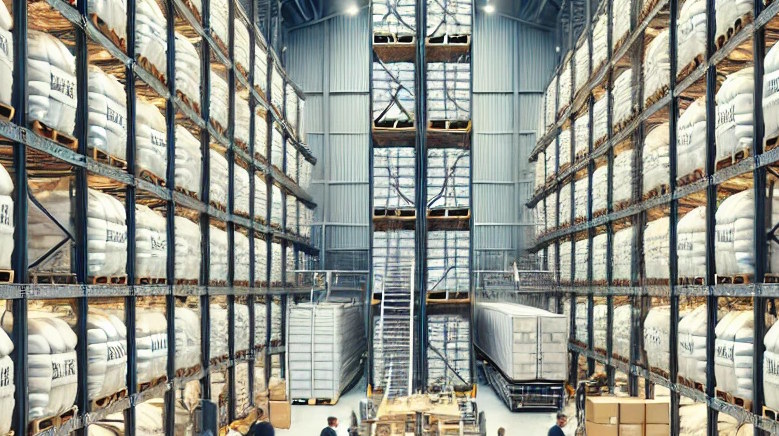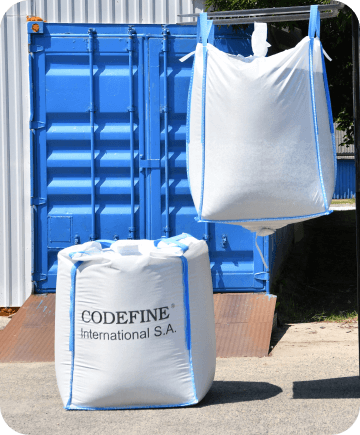Home » Posts Page » Blog » Products and Materials » Top 5 Tips for Keeping Sensitive Products Dry in Anti-Humidity FIBC Bulk Bags

It might seem innocuous enough, but humidity can wreak havoc on delicate materials. At high enough levels, humidity can lead to the buildup of moisture within bulk packaging solutions like FIBCs. When used to handle and store things like fine powders and granular materials, this moisture can saturate contents, making them unfit for purpose and unsuitable for sale. High humidity and moisture are also a concern when using bulk packaging to store finished products with sensitive elements such as electronics. Here, the margin for loss is even higher.
Many different industries need to take the issue of humidity seriously. It’s a major problem for the pharmaceutical and chemical industries, which typically use FIBCs and bulk containers to store fine powders. In a worst-case scenario, moisture intrusion can even trigger hazardous reactions when it’s exposed to particular substances. Construction materials can also become ruined when exposed to high levels of moisture, while high enough humidity can lead to spoilage of food products, rendering them unfit for human consumption.
As they’re made from woven polypropylene material, most FIBCs boast some degree of breathability. This can help combat the issue of humidity and reduce moisture buildup but doesn’t negate the problem entirely. When it’s humid, a significant quantity of water vapor collects in the air.
When temperatures swing down slightly, this water vapor returns to a liquid form, which collects as condensation on the inside of FIBCs. Unfortunately, the woven design of FIBCs means they’re not entirely watertight, meaning vapor will eventually condense on the inside of containers. Over time, sufficient amounts of moisture can saturate stored contents, triggering unwanted reactions and saturating materials.
The good news is that moisture exposure is easy enough to catch before it becomes major problem. FIBCs themselves can become degraded when exposed to enough moisture, with a tell-tale sign being frayed seams. Generally speaking, material integrity can become compromised when exposed to moisture, with the fabric of FIBCs weakening over time. Other than the visible evidence of condensation, other notable signs of moisture exposure include mold growth.
Regularly inspecting the condition of FIBCs will go a long way in keeping the effects of humidity and moisture exposure in check. While some compromised FIBCs can be aired out to release excess moisture, others will need to be retired from use if the damage is severe enough.
Searching for ways to safeguard your FIBCs and their contents from humidity? Below are just a few things you can try to keep products dry when using anti-humidity bags.
Coated FIBCs are simply standard FIBCs that have been enhanced with a laminated PP film layer. This film layer can be added to the interior exterior of an FIBC and is typically very thin. Once applied, this film layer can significantly reduce airflow, preventing water vapor and moisture from penetrating FIBC fabric.
One of the most effective ways to protect products against moisture is to use a lined FIBC. As the name suggests, a lined FIBC is simply a container that’s been equipped with a separate film liner on the inside and can be made from a variety of materials, including polyethylene and polypropylene. As well as protecting against moisture, lined FIBCs are an effective choice if you’re looking to prevent product sifting.
Easily added to the inside of FIBCs, liners can also simplify product handling, allowing for easier filling and unloading. They’re commonly employed by the food manufacturing sector to handle ingredients, while they’re also a popular choice in the construction industry for handling granular materials like cement.
Poly covers are another useful tool for keeping moisture at bay. Made from hard-wearing polyethylene, these covers also protect against UV damage. They’re designed to fit snugly over FIBCs and are easily attached with strapping or film. They’re also incredibly versatile and available in a range of sizes and thicknesses. Additionally, they can be readily customized with bespoke branding or product identifiers.
It’s not just moisture from the air that poses a problem for FIBCs and their contents. Sometimes, ground-based moisture is the issue and calls for a separate solution. Slip sheets are the perfect remedy for ground-level moisture, serving as an impermeable barrier between the ground and the base of FIBCs. Slip sheets can be made from a range of materials, with fiberboard and plastic being two popular options. As well as helping keep products dry, slip sheets are incredibly effective at stabilizing pallet loads.
Performing a similar function to poly covers, shrink poly film is a more flexible anti-humidity measure that perfectly adapts to the contours of an FIBC and its contents. When heat is applied to shrink poly film, the material shrinks and conforms around an FIBC, protecting against moisture and stabilizing the load. As with regular poly covers, shrink film poly covers can be customized with branding or product identification details.
Sometimes, even the best anti-humidity bags need a little help to ensure products are protected against moisture. Container desiccants make a welcome addition to FIBCs, absorbing excess moisture from FIBC interiors to prevent damage. They’re particularly handy for long-term storage or shipping of products and are available in a range of sizes.
While they won’t do anything to control humidity levels themselves, humidity indicator cards (HICs) are a useful tool for controlling moisture levels within FIBCs. These cards feature indicator spots that change color as humidity levels change, alerting you to any significant swings and allowing you to intervene when necessary.
Whether you’re regularly handling sensitive chemicals or operating within the food processing sector, anti-humidity bags are a vital part of any operation. Essential for protecting delicate products and materials from moisture damage, they’re a must if you’re looking to prevent spoilage and dangerous reactions.
In the market for anti-humidity FIBC solutions? You’ve come to the right place. Codefine has been at the forefront of innovative bulk packaging design since 1957, pioneering state-of-the-art solutions that are today used across just about every industry sector. Interested in learning more about our anti-humidity bags? Explore our complete product range online today. Do you have a question about our products or need to discuss your requirements in more detail? Feel free to get in touch.
